
Concept explainers
(a)
Interpretation: The structure that corresponds to the given name is to be drawn.
Concept introduction: One should follow the given three steps to derive the structure of the compound from its IUPAC name. The first step involves the identification of parent name and
Answer to Problem 25.39P
The structure that corresponds to the given name is,
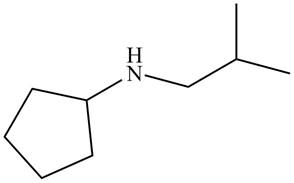
Figure 1
Explanation of Solution
The name of the given molecule suggests that a nitrogen atom is bonded to cyclopentane and isobutyl group. Cyclopentane consists of five carbon atoms. Therefore, the structure of the given compound is,
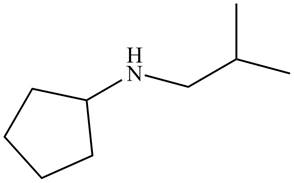
Figure 1
The structure that corresponds to the given name is shown in Figure 1.
(b)
Interpretation: The structure that corresponds to the given name is to be drawn.
Concept introduction: One should follow the given three steps to derive the structure of the compound from its IUPAC name. The first step involves the identification of parent name and functional group found at the end of the name. The second step is numbering of carbon skeleton in either direction. The third step is addition of substituents at appropriate carbon atoms.
Answer to Problem 25.39P
The structure that corresponds to the given name is,
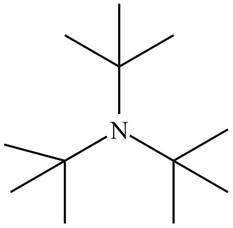
Figure 2
Explanation of Solution
The name of the given compound is tri-tert-butylamine. Prefix ‘tri’ shows that a nitrogen atom is bonded to three tert-butyl groups. Therefore, the structure of the given compound is,
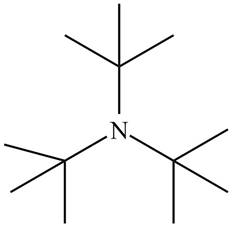
Figure 2
The structure that corresponds to the given name is shown in Figure 2.
(c)
Interpretation: The structure that corresponds to the given name is to be drawn.
Concept introduction: One should follow the given three steps to derive the structure of the compound from its IUPAC name. The first step involves the identification of parent name and functional group found at the end of the name. The second step is numbering of carbon skeleton in either direction. The third step is addition of substituents at appropriate carbon atoms.
Answer to Problem 25.39P
The structure that corresponds to the given name is,
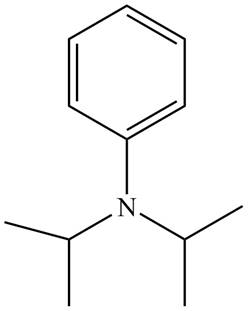
Figure 3
Explanation of Solution
The name of the given compound is N, N-diisopropylaniline. Prefix ‘di’ shows that a nitrogen atom is bonded to two isopropyl groups and it is bonded to six membered
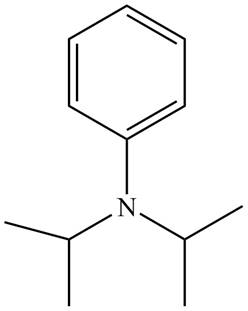
Figure 3
The structure that corresponds to the given name is shown in Figure 3.
(d)
Interpretation: The structure that corresponds to the given name is to be drawn.
Concept introduction: One should follow the given three steps to derive the structure of the compound from its IUPAC name. The first step involves the identification of parent name and functional group found at the end of the name. The second step is numbering of carbon skeleton in either direction. The third step is addition of substituents at appropriate carbon atoms.
Answer to Problem 25.39P
The structure that corresponds to the given name is,
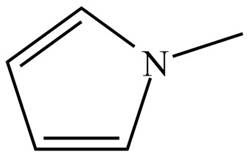
Figure 4
Explanation of Solution
The name of the given compound is N-methylpyrrole. Pyrrole is the parent chain of the given compound. It is an aromatic five membered ring which contains nitrogen atom and two double bonds. The nitrogen atom is bonded to methyl group. Therefore, the structure of the given compound is,

Figure 4
The structure that corresponds to the given name is shown in Figure 4.
(e)
Interpretation: The structure that corresponds to the given name is to be drawn.
Concept introduction: One should follow the given three steps to derive the structure of the compound from its IUPAC name. The first step involves the identification of parent name and functional group found at the end of the name. The second step is numbering of carbon skeleton in either direction. The third step is addition of substituents at appropriate carbon atoms.
Answer to Problem 25.39P
The structure that corresponds to the given name is,
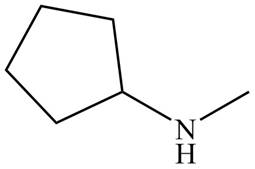
Figure 5
Explanation of Solution
The name of the given compound is N-methylcyclopentanamine. The name suggests that nitrogen atom is bonded to cyclopentane and methyl group. Therefore, the structure of the given compound is,

Figure 5
The structure that corresponds to the given name is shown in Figure 5.
(f)
Interpretation: The structure that corresponds to the given name is to be drawn.
Concept introduction: One should follow the given three steps to derive the structure of the compound from its IUPAC name. The first step involves the identification of parent name and functional group found at the end of the name. The second step is numbering of carbon skeleton in either direction. The third step is addition of substituents at appropriate carbon atoms.
Answer to Problem 25.39P
The structure that corresponds to the given name is,
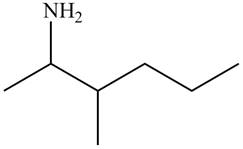
Figure 6
Explanation of Solution
The name of the given compound is

Figure 6
The structure that corresponds to the given name is shown in Figure 6.
(g)
Interpretation: The structure that corresponds to the given name is to be drawn.
Concept introduction: One should follow the given three steps to derive the structure of the compound from its IUPAC name. The first step involves the identification of parent name and functional group found at the end of the name. The second step is numbering of carbon skeleton in either direction. The third step is addition of substituents at appropriate carbon atoms.
Answer to Problem 25.39P
The structure that corresponds to the given name is,
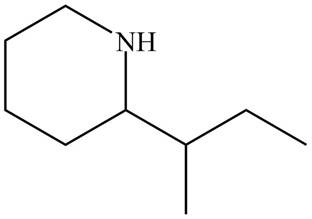
Figure 7
Explanation of Solution
The name of the given compound is

Figure 7
The structure that corresponds to the given name is shown in Figure 7.
(h)
Interpretation: The structure that corresponds to the given name is to be drawn.
Concept introduction: One should follow the given three steps to derive the structure of the compound from its IUPAC name. The first step involves the identification of parent name and functional group found at the end of the name. The second step is numbering of carbon skeleton in either direction. The third step is addition of substituents at appropriate carbon atoms.
Answer to Problem 25.39P
The structure that corresponds to the given name is,
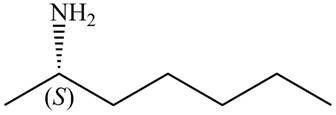
Figure 8
Explanation of Solution
The name of the given compound is (S)-heptan-

Figure 8
The structure that corresponds to the given name is shown in Figure 8.
Want to see more full solutions like this?
Chapter 25 Solutions
PKG ORGANIC CHEMISTRY
- Identify the compound with the longest carbon - nitrogen bond. O CH3CH2CH=NH O CH3CH2NH2 CH3CH2C=N CH3CH=NCH 3 The length of all the carbon-nitrogen bonds are the samearrow_forwardIdentify any polar covalent bonds in epichlorohydrin with S+ and 8- symbols in the appropriate locations. Choose the correct answer below. Η H's+ 6Η Η Η Η Η Ηδ Η Ο Ο HH +Η Η +Η Η Η -8+ CIarrow_forwardH H:O::::H H H HH H::O:D:D:H HH HH H:O:D:D:H .. HH H:O:D:D:H H H Select the correct Lewis dot structure for the following compound: CH3CH2OHarrow_forward
- Rank the following compounds in order of decreasing boiling point. ннннн -С-С-Н . н-с- ННННН H ΗΤΗ НННН TTTĪ н-с-с-с-с-о-н НННН НН C' Н н-с-с-с-с-н НН || Ш НННН H-C-C-C-C-N-H ННННН IVarrow_forwardRank the following compounds in order of decreasing dipole moment. |>||>||| ||>|||>| |>|||>|| |||>||>| O ||>>||| H F H F H c=c || H c=c F F IIIarrow_forwardchoose the description that best describes the geometry for the following charged species ch3-arrow_forward
- Why isn't the ketone in this compound converted to an acetal or hemiacetal by the alcohol and acid?arrow_forwardWhat is the approximate bond angle around the nitrogen atom? HNH H Harrow_forwardOH 1. NaOCH2CH3 Q 2. CH3CH2Br (1 equiv) H3O+ Select to Draw 1. NaOCH2 CH3 2. CH3Br (1 equiv) heat Select to Edit Select to Drawarrow_forward
- Complete and balance the following half-reaction in acidic solution. Be sure to include the proper phases for all species within the reaction. S₂O₃²⁻(aq) → S₄O₆²⁻(aq)arrow_forwardQ Select to Edit NH3 (CH3)2CHCI (1 equiv) AICI 3 Select to Draw cat. H2SO4 SO3 (1 equiv) HO SOCl2 pyridine Select to Edit >arrow_forwardComplete and balance the following half-reaction in basic solution. Be sure to include the proper phases for all species within the reaction. Zn(s) → Zn(OH)₄²⁻(aq)arrow_forward
 Organic Chemistry: A Guided InquiryChemistryISBN:9780618974122Author:Andrei StraumanisPublisher:Cengage Learning
Organic Chemistry: A Guided InquiryChemistryISBN:9780618974122Author:Andrei StraumanisPublisher:Cengage Learning
